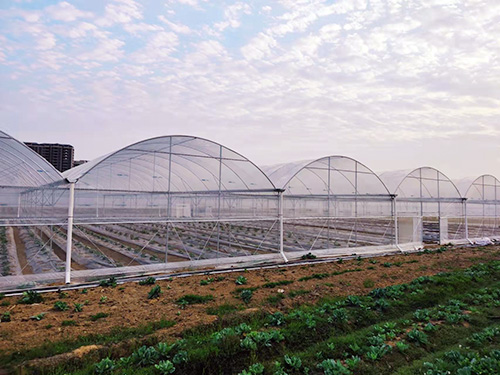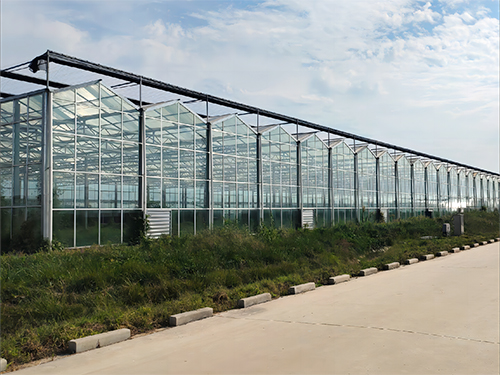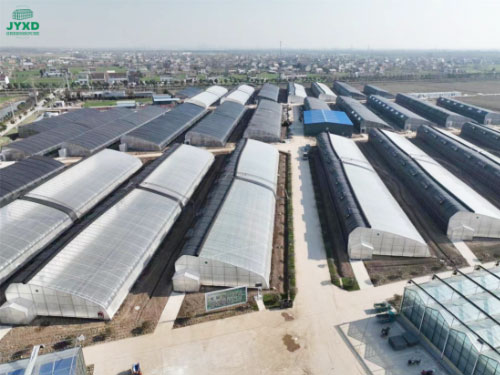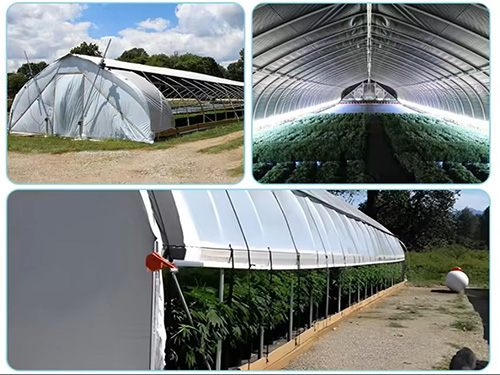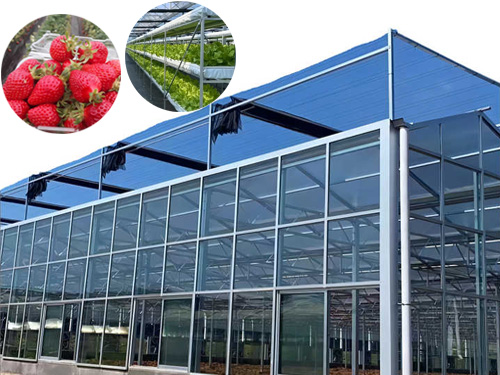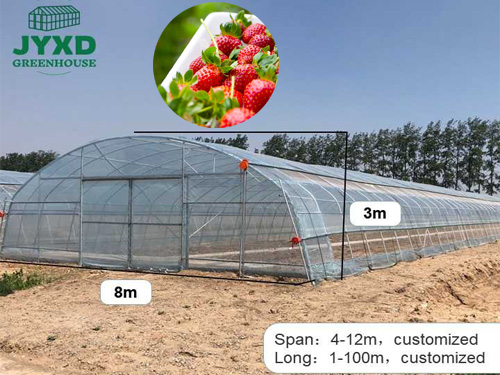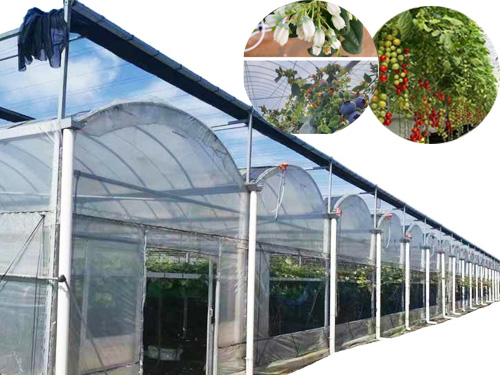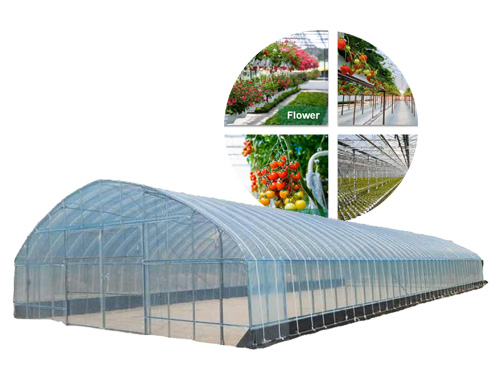NEWS DETAILS
NEWS INFORMATION
Addressing the Challenge of High Humidity in Greenhouses: Solutions and Management Tips
AUTHOR:jyxd-greenhouse DATE:2024-11-30 00:09:17 HITS:128
In greenhouse cultivation, controlling humidity is crucial for the healthy growth of plants. Excessive humidity not only affects photosynthesis, reducing water absorption, but can also lead to the growth of mold, fungi, and other diseases, which in turn impacts crop quality and yield. Effective humidity control is key to ensuring a stable greenhouse environment and promoting healthy plant growth. This article explores the causes of high humidity in greenhouses, provides effective humidity control solutions, and shares management tips to help growers overcome this challenge.
1. Causes of High Humidity in Greenhouses
Understanding the root causes of high humidity can help growers implement targeted control measures. Common causes of high humidity in greenhouses include:
a) Inadequate Ventilation
Improperly designed or poorly functioning ventilation systems can lead to slow air movement, preventing moisture from effectively escaping. This issue is especially prevalent in warm conditions with high transpiration rates from plants, leading to humidity buildup.
b) Overwatering
Excessive irrigation, particularly with drip or sprinkler systems, can introduce too much moisture into the greenhouse air, raising humidity levels and impacting plant growth.
c) Too-Tight Greenhouse Sealing
While a tightly sealed greenhouse can effectively maintain temperature, if sealed too tightly, water vapor will have difficulty evaporating, resulting in excessive humidity accumulation.
d) Excessive Transpiration from Plants
In conditions of adequate light and warmth, plants release large amounts of water, increasing the moisture content in the air. If the greenhouse does not effectively control moisture expulsion, high humidity becomes a problem.
Keywords: greenhouse humidity control, causes of high humidity, greenhouse ventilation
2. Solutions for Controlling Humidity in Greenhouses
To effectively manage greenhouse humidity, a comprehensive approach is essential. Here are several solutions and management tips to help reduce humidity levels inside the greenhouse:
a) Enhance Ventilation
Ventilation is the most basic and effective method of controlling humidity in a greenhouse. Ensuring proper air circulation helps prevent moisture accumulation. Ways to enhance ventilation include:
Install Automated Ventilation Systems: Automatically adjusting fans, windows, or doors helps maintain air movement and expel moisture in a timely manner.
Proper Placement of Vent Openings: Setting intake and exhaust vents at strategic locations promotes air circulation and keeps humidity in balance.
Use Exhaust Fans: High-efficiency exhaust fans can quickly expel humid air from the greenhouse, lowering humidity.
b) Control Irrigation Volume and Methods
Irrigation practices have a significant impact on greenhouse humidity. Over-irrigation not only wastes water but also increases indoor humidity. Therefore, controlling irrigation volume is crucial.
Use Drip Irrigation: Drip irrigation precisely delivers water to plant roots, reducing water waste and evaporation, which helps lower air humidity.
Scheduled Irrigation: Avoid irrigating during peak transpiration times in the afternoon. Opt for morning or evening watering to reduce sudden humidity spikes.
Install Humidity Sensors: Humidity sensors can monitor the greenhouse environment and pause the irrigation system if humidity levels are too high.
c) Install Dehumidification Equipment
In regions with particularly high humidity or during wet weather, dehumidification devices can effectively lower moisture levels in the air.
Dehumidifiers: Commercial-grade dehumidifiers can quickly and efficiently reduce greenhouse moisture, especially during rainy seasons or in high-humidity areas.
Desiccants: Placing desiccant bags in corners of the greenhouse helps absorb excess moisture, maintaining appropriate humidity.
d) Use Shade Nets and Adjust Plant Spacing
Shade nets and plant spacing adjustments can effectively slow down moisture buildup and improve air circulation inside the greenhouse.
Use Shade Nets: Shade nets not only help regulate light intensity but also prevent excessive water evaporation into the air, reducing humidity.
Increase Plant Spacing: Ensure enough space between plants to allow air to circulate freely, aiding moisture expulsion.
e) Improve Greenhouse Structure for Ventilation
Ensure the greenhouse structure is designed to promote heat dissipation to prevent excessive heat buildup, which can impede moisture expulsion. Using breathable materials and proper structural design can facilitate moisture flow and lower humidity.
Keywords: greenhouse dehumidification, drip irrigation system, greenhouse ventilation
3. Intelligent Management of Humidity Control in Greenhouses
With technological advancements, modern greenhouses increasingly incorporate intelligent management systems. These systems allow real-time monitoring of temperature and humidity data and automatically adjust the greenhouse environment. This not only improves humidity control efficiency but also reduces energy consumption.
a) Temperature and Humidity Sensors with Control Systems
By installing temperature and humidity sensors, greenhouse humidity can be monitored in real time. When humidity exceeds a set threshold, the system can automatically activate exhaust fans, dehumidifiers, or adjust the irrigation schedule to maintain optimal humidity levels.
Remote Monitoring: Growers can use mobile apps or computer platforms to monitor temperature and humidity data at any time and make adjustments as needed.
Automated Control: Intelligent systems can automatically adjust humidity levels based on temperature and humidity fluctuations, eliminating the need for manual intervention.
b) Data Analysis and Optimization
Intelligent greenhouse management systems can not only control temperature and humidity in real time but also optimize humidity control strategies through data analysis. For example, the system can analyze humidity variations under different seasonal and weather conditions and adjust control strategies accordingly to maintain consistent humidity levels.
Keywords: intelligent temperature and humidity control, automated management, temperature and humidity sensors
4. Success Case: Practical Humidity Management in Greenhouses
Case Overview: A greenhouse farm successfully addressed high humidity issues by implementing a comprehensive humidity control plan.
Ventilation System: The farm installed high-efficiency fans and an automated window system to ensure smooth airflow, effectively adjusting humidity levels.
Dehumidification Equipment: Dehumidifiers were installed during high-humidity seasons, successfully maintaining humidity within the desired range.
Irrigation Control: The farm adopted scheduled irrigation and drip systems to effectively reduce evaporation, lowering indoor humidity levels.
Results: Effective humidity management significantly reduced disease occurrence, leading to notable improvements in both crop yield and quality.
Keywords: humidity control case, greenhouse humidity management
5. Conclusion
Humidity control in greenhouses is essential for promoting healthy plant growth and improving yields. By enhancing ventilation, managing irrigation wisely, installing dehumidifying equipment, and utilizing intelligent management systems, growers can effectively tackle high humidity challenges. Humidity control not only benefits plant growth but also prevents disease outbreaks, improving the overall profitability of greenhouse farming. We hope the humidity control solutions provided in this article will help you address high humidity issues and create a healthier, more stable growing environment.
Hebei Juyou Xinda Greenhouse Facilities Co.,Ltd.
Copyright © 2024-2025 https://www.jyxd-greenhouse.com. All Rights Reserved Hebei Juyou Xinda Greenhouse Facilities Co.,Ltd.Copyright





 Current Location:
Current Location: